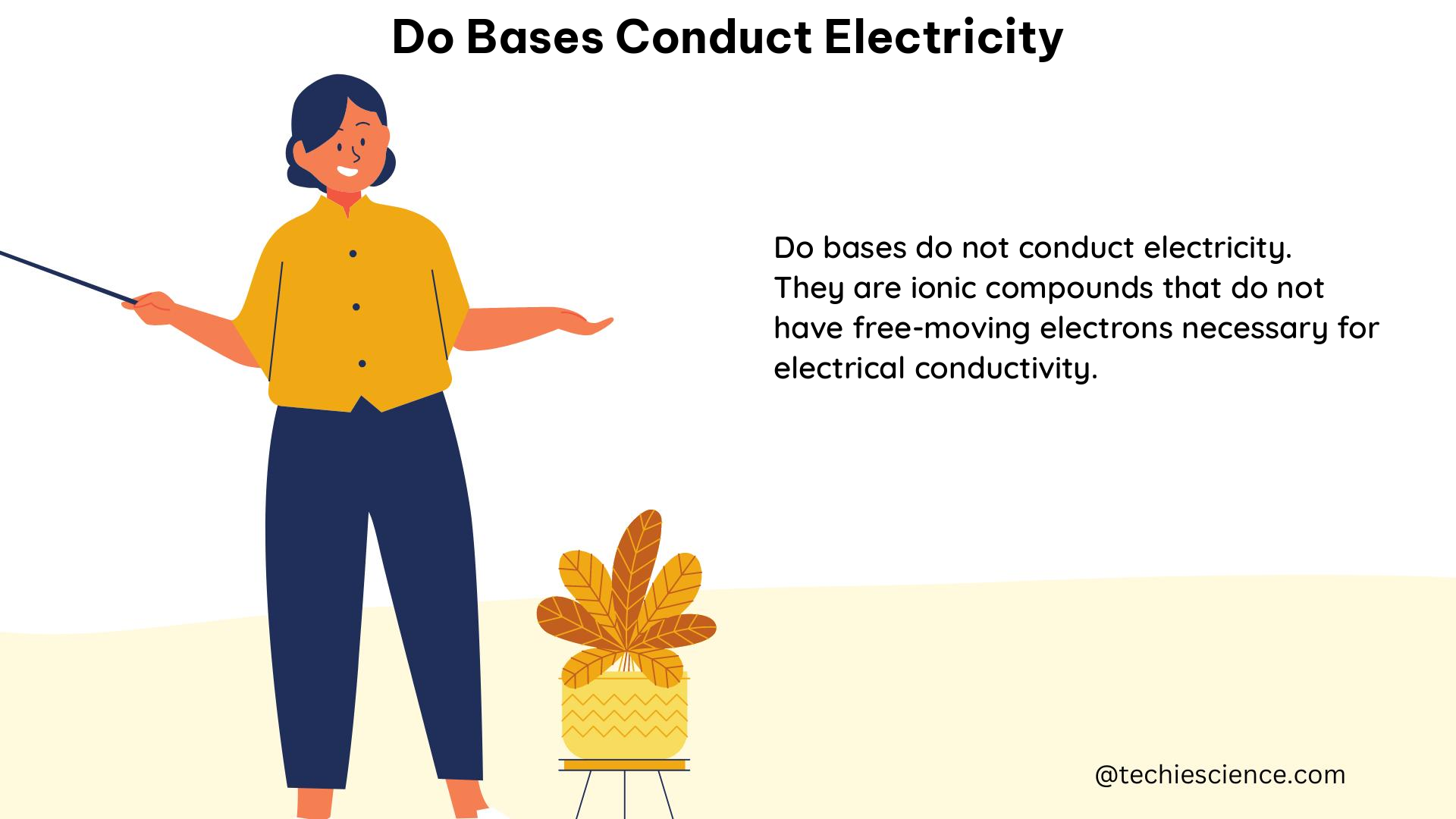Bases, when dissolved in water, can conduct electricity due to the presence of ions in the aqueous solution. This is because bases are electrolytes, meaning they can dissociate into ions when dissolved in water. These ions then facilitate the flow of electric current through the solution.
Understanding Electrical Conductivity in Aqueous Solutions
The electrical conductivity of an aqueous solution depends on the concentration and mobility of the ions present. When a base, such as sodium hydroxide (NaOH), is dissolved in water, it dissociates into sodium (Na+) and hydroxide (OH-) ions, as shown in the following equation:
NaOH → Na+ + OH-
These ions are capable of carrying electric charge through the solution, thereby making the solution conductive.
The conductivity of the solution is the sum of the individual ionic conductivities of all the ions present. The conductivity of a solution can be measured using a conductivity meter, which provides a quantitative measure of the solution’s ability to conduct electricity.
Factors Affecting Electrical Conductivity of Bases
-
Ion Concentration: The higher the concentration of ions in the solution, the greater the electrical conductivity. As more base is dissolved, the number of ions increases, leading to higher conductivity.
-
Ion Mobility: The mobility of the ions, which is determined by their size and charge, also affects the conductivity. Smaller and more highly charged ions, such as H+ and OH-, have higher mobilities and contribute more to the overall conductivity.
-
Temperature: Increasing the temperature of the solution can enhance the mobility of the ions, leading to an increase in electrical conductivity.
-
Degree of Dissociation: The extent to which a base dissociates into ions in water can also influence the conductivity. Stronger bases, such as sodium hydroxide (NaOH), tend to have a higher degree of dissociation, resulting in greater conductivity compared to weaker bases.
Conductimetric Titrations

Conductivity measurements can be particularly useful in acid-base titrations, where the conductivity of the solution changes as the titration progresses. This technique is known as conductimetric titration.
During the titration of a base with an acid, the conductivity of the solution initially decreases as the H+ and OH- ions are consumed. At the equivalence point, the conductivity reaches a minimum, as the solution contains only the ions of the resulting salt. After the equivalence point, the conductivity increases again as the excess titrant (either acid or base) is added, introducing more ions into the solution.
By monitoring the changes in conductivity during the titration, the equivalence point can be determined, which is useful in identifying the stoichiometry of the reaction and the concentration of the reactants.
Conductimetric Titration of Polyprotic Acids
Conductimetry can also be used to determine the number of protons that a polyprotic acid can donate. In the titration of a polyprotic acid, such as phosphoric acid (H3PO4), the conductivity of the solution will decrease as each proton is neutralized, and then increase again as the next proton is neutralized.
By analyzing the changes in conductivity during the titration, the number of protons that the acid can donate can be determined. This information is valuable in understanding the acid’s chemical properties and its behavior in various applications.
Numerical Example
Consider the titration of 50 mL of 0.1 M sodium hydroxide (NaOH) with 0.1 M hydrochloric acid (HCl). The reaction can be represented as:
NaOH + HCl → NaCl + H2O
At the equivalence point, the conductivity of the solution will reach a minimum, as the H+ and Cl- ions are consumed, and the solution contains only the ions of the resulting salt, Na+ and Cl-.
Assuming the equivalent conductivities of the ions are:
– H+ = 349.8 S·cm2/mol
– OH- = 198.0 S·cm2/mol
– Na+ = 50.1 S·cm2/mol
– Cl- = 76.3 S·cm2/mol
We can calculate the conductivity of the solution before the equivalence point (when H+ and OH- are present) and after the equivalence point (when only Na+ and Cl- are present).
Before the equivalence point:
– Conductivity = (0.1 M × 349.8 S·cm2/mol) + (0.1 M × 198.0 S·cm2/mol) = 54.78 mS/cm
At the equivalence point:
– Conductivity = (0.1 M × 50.1 S·cm2/mol) + (0.1 M × 76.3 S·cm2/mol) = 12.64 mS/cm
The conductivity of the solution reaches a minimum at the equivalence point, as the H+ and Cl- ions are consumed, and the solution contains only the ions of the resulting salt, Na+ and Cl-.
Conclusion
Bases, when dissolved in water, can conduct electricity due to the presence of ions in the aqueous solution. The electrical conductivity of a base-containing solution depends on factors such as ion concentration, ion mobility, temperature, and the degree of dissociation of the base.
Conductivity measurements can be particularly useful in acid-base titrations, where the conductivity of the solution changes as the titration progresses. This technique, known as conductimetric titration, can be used to determine the equivalence point of the reaction and the number of protons that a polyprotic acid can donate.
By understanding the principles of electrical conductivity in aqueous solutions and the applications of conductimetric titrations, chemists and physicists can gain valuable insights into the behavior of bases and their interactions with other chemical species.
References:
1. Electrical resistance and conductance – Wikipedia
2. Do bases conduct electricity? | Socratic
3. 13.5: Acid/Base Titration – Chemistry LibreTexts
4. Why do acids and bases both conduct electricity? – Socratic
5. ELECTRICAL CONDUCTIVITY – Cerritos College Chemistry Lab Manual
Hi, I’m Akshita Mapari. I have done M.Sc. in Physics. I have worked on projects like Numerical modeling of winds and waves during cyclone, Physics of toys and mechanized thrill machines in amusement park based on Classical Mechanics. I have pursued a course on Arduino and have accomplished some mini projects on Arduino UNO. I always like to explore new zones in the field of science. I personally believe that learning is more enthusiastic when learnt with creativity. Apart from this, I like to read, travel, strumming on guitar, identifying rocks and strata, photography and playing chess.